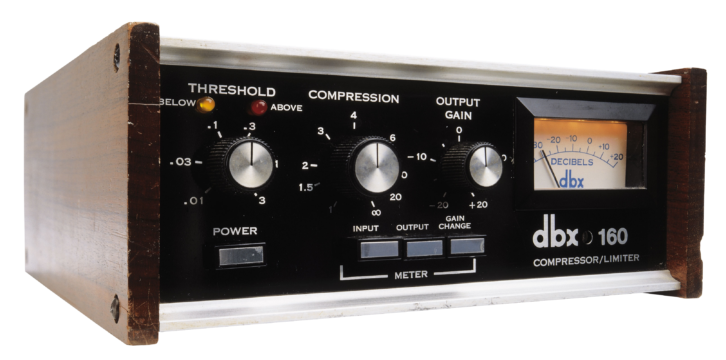
By Ian Anderson
David Blackmer received his training in electronics first from the Navy and later from both Harvard and MIT. As was most often the case in that 1960s audio era, Blackmer’s interest as an engineer and circuit designer focused largely on maximizing the dynamic range of recorded media.
Recall that the LP vinyl record of the time had a rather restricted—read: compressed—dynamic range in the neighborhood of 60 – 70 dB. Classical orchestral music can easily exceed this by 30 dB. With this in mind, Blackmer set about expanding the dynamic range of recorded media. So deliberate was his focus that Blackmer, in 1971, named his company after his goal of deciBel expansion: dbx.

During the process of designing noise reduction systems for tape recorders (dbx’s first, and often overlooked, products), Blackmer, in 1971, developed the core of what would ultimately be his greatest legacy, the Blackmer Gain Cell: four transistors—two NPN, two PNP—arranged as complementary current mirrors, one pair able to alter the current flow through the other upon receipt of an incoming control current. While the VCA itself was not exactly new (analog synthesizers were using voltage-controlled amplifiers to shape a sound’s envelope in the late 1960s), Blackmer’s invention was the first VCA with low enough noise and distortion to make it suitable for use in professional audio products. The Blackmer gain cell was patented in 1973.
The key to maximizing the performance of these VCAs lay in the painstaking process of matching individual transistors to one another, and thermally coupling them to ensure consistent performance: a transistor’s transfer characteristics can change depending on the component’s temperature. The importance of ensuring all transistors (after they have been matched to one another, of course) exist in the same thermal environment cannot be understated. This four-transistor design ultimately formed the basis of every iteration of the Blackmer gain cell, including the seven-transistor 200 “silver can” VCA—the first to market—used in the 160 and 161 compressors.
The next development came in 1978 with the addition of interleaved local feedback loops to reduce distortion. This brought the transistor count up to eight. The first commercial appearance of this circuit was the 202 “black can” VCA at the heart of the 165. The 200 and 202 VCAs had a -6 mV/dB logarithmic curve: every 6 mV change in control voltage results in a signal level change of 1dB at the VCA’s output. dbx called this a “decilinear” curve: logarithmic changes (the decibel) in the audio signal were the result of linear changes in the control voltage.
The Blackmer Gain Cell
The Blackmer gain cell was the first voltage-controlled gain-changing device to do this. This is important to note, as designers of compressors and limiters based on other topologies at the time, like JFETs, diode bridges, electro-optical cells and the variable-µ vacuum tube, were limited by the transfer curve (which was often decidedly nonlinear in nature) of the gain reduction cell itself.
Both the 200 and 202 VCAs—in fact, all but one Blackmer gain cell, the 2001—are class A/B devices that require careful trimming to minimize crossover distortion.
Meanwhile, in 1980, audio engineer Paul Buff of Allison Research (which eventually merged with Valley Audio in Nashville to become Valley People) developed his own eight-transistor device, the class A TA-101, which formed the core of Valley People products like the famed Kepex, Gain Brain and Dynamite. The TA-101 wasn’t exactly a VCA, though. It was actually an eight-transistor array (hence “TA”) consisting of four matched NPN and four matched PNP transistors in a .435-inch square package around which a skilled designer could build a VCA.
Further, in a VCA application, four of the transistors are connected as diodes, which aids in maintaining audio waveform symmetry without the need for careful external trimming. The earlier ECG-101 is functionally identical to the TA-101, though the package is different. Owners of some vintage VCA-automated Harrison consoles (Harrison, incidentally, also being located in Nashville) will find an ECG-101 on each of their faders. It is worth mentioning that the Buff transistor array is similar enough to the Blackmer VCA that Allison/Valley People paid some royalties to dbx.
The first monolithic integrated circuit version of the Blackmer gain cell, the dbx 2150, was released in 1981 in the now-familiar 8-pin SIP package. The much smaller form factor, along with the current in/current out nature of the Blackmer VCA, enabled designers to cost-effectively use multiple VCAs in parallel. Four 2150s wired in parallel, for example, yields a 6dB improvement in signal-to-noise ratio. It is this principle upon which all of the later open-frame Blackmer VCAs are based.
dbx was purchased by Birmingham Sound Reproducers (BSR) in 1979. During this period the dbx brand name was found on numerous consumer audio devices, including turntables, tape decks and amplifiers. It was also during this period that the 160x and 160XT were released.
In 1989, the dbx division of BSR was acquired by Edison Laser Player, a Japanese company whose founder, Sanju Chiba, invented the laser turntable. The professional products division was then sold to AKG, which was in turn purchased by Harman International in 1994.
At this time a number of critical patents were sold to THAT Corp (THAT is an acronym formed by the surnames of Les Tyler, Gary Hebert and Paul Traveline), whose 218x ICs—direct descendants of the original Blackmer gain cell—are still in use by companies like Solid State Logic, Smart Research, and various other manufacturers of VCA compression devices.
The dbx 160 and Its Progeny
First things first: no iterations of the “classic” dbx 160 or its relatives ever shipped with input or output transformers as standard. All iterations of the dbx 160, including the 161, the 160X, the 160XT, the 160A, the 162 and the 165, used electronically balanced or unbalanced inputs and outputs built around operational amplifiers. Only the contemporary 160SL and 162S shipped with transformers, and only on the outputs; inputs on these devices remained electronically balanced.
Each of these devices (as is the case with every VCA compressor the author can think of) also has a very short internal signal path:
Input stage -> VCA -> current-to-voltage converter -> output driver
The current-to-voltage converter, or “I/V” converter, is also known as a transimpedance amplifier, and is almost exclusively executed with a simple inverting op-amp stage (typically those with high impedance JFET inputs). The I/V converter is necessary as VCAs are current in/current out devices.
All of the 160-derived devices are also feed-forward designs, wherein the control voltage driving the VCA into gain reduction is derived from the input signal and “fed forward” to the VCA, rather than being “fed backward” from the signal after it has already passed through the VCA. This allows for much faster attack times that can drive the signal into large amounts of gain reduction more transparently than a feed-back design.
The Original dbx 160 ‘VU’ (1976)
Released in 1976, dbx’s first dynamic range compressor for professional audio was reportedly not a particularly popular idea with Blackmer, whose primary objective was to increase the dynamic range of recorded audio. Nevertheless, the two-rackspace, half-width box would prove popular with engineers looking for inexpensive alternatives to, say, the LA-3A and 1176 in spite of its limited feature set.
It is also important to note that the 160s compression curve was a “hard knee” curve: the onset of compression was instantaneous and often resulted in noticeable compression depending on ratio and threshold settings. As is often the case with audio devices that have earned “classic” status, these shortcomings weren’t necessarily a bad thing and often contribute to their desirability.
The dbx 160 VU model used the first commercial version of the Blackmer gain cell, the 200 VCA, and its companion RMS detector, the 207/208. These were both discrete-transistor devices on small printed circuit boards potted in metal enclosures.
Another persistent myth about the 160VU is that it has balanced I/O. The input stage is indeed a textbook differential amplifier built around a TL082 FET op-amp with a gain of -6 dB, but the output driver is a bit different and is, in fact, unbalanced. Here, a non-inverting, “ground-canceling output” driver circuit is used. Where a fully balanced output will produce the “hot” output signal on XLR pin 2 and an inverted or anti-phase signal (“cold”) on XLR pin 3, the 160 VU’s ground-canceling output is a single output op-amp stage with push-pull drive transistors driving pin 2, with pin 3 designed to cancel out any errant voltages, i.e., ground hum, that might appear on pin 1 (ground). Gain of this stage is set at +10dB.
So what are the real differences between the 160 and 161 VU models? First and foremost, the 161’s inputs and outputs are unbalanced on RCA connectors and calibrated for -10dBV (consumer audio). The 161’s output stage also lacks the output drive transistors as well as the ground-cancelling circuitry and will also have a higher output impedance. In fact, the 161’s post-VCA current-to-voltage conversion op-amp stage is serving double duty as the output driver.
The dbx 162 (1978)
The dbx 162 is often referred to as a stereo 160 VU. This isn’t quite the case. Unsurprisingly, there are a few key differences. First, where the core of the 160 VU was the 200 VCA and 207 RMS detector, the 162 used the 210 VCA, a four-transistor device (a pair of complementary current mirrors; the true “core” of the Black gain cell) on a daughter card instead of the expected potted can. Stereo operation is made possible by a dual RMS detector (also on a daughter card) with two inputs and a single output: both channels are summed to a single sidechain.
There is also a mysterious unpopulated header on the motherboard similar to those upon which the VCAs and RMS detector are mounted. In a telephone conversation with David Kulka of Burbank, California’s Studio Electronics, Kulka pointed out that this header resides between the input buffer and RMS detectors, suggesting some manner of optional sidechain insert functionality.
Inputs are balanced differential amplifiers. Outputs, like those on the 165, are unbalanced and ground-canceling. Both inputs and outputs remain on terminal strips.
The threshold control is still labeled in Volts, though the author has seen two versions of the front panel: an older version retains the 160 VU’s 10mV to 3V threshold labeling, while a newer version omits the unit altogerther and is simply labeled “.01” to “3.”
The dbx 165, 165A (1978)
Also released in 1978, the 165 was clearly intended to be the flagship dynamics device in the dbx professional audio lineup. Built around the newest eight-transistor 202 VCA (the “black can” version of the later VCA used in automation systems in consoles by MCI, SSL and others) and an 8-pin DIP IC RMS detector, the 165 featured a fully balanced differential amplifier input, though the output is still, as stated in the 165 manual, “…single ended, so that in normal operation, the [cold] signal output terminal is internally connected to the [ground] terminal.”
The 165 adds attack and release controls, a threshold control with proper dB units and, most significantly, was the first dbx device to feature Over Easy soft-knee compression. Unlike its predecessors, the 165 was capable of stereo linking using a proprietary cable available from dbx. The 165 also adds sidechain detector access on the I/O terminal strip.
The 165A adds the Peak Stop Limiter, a diode-based hard limiter that most folks agree doesn’t sound particularly good.
The dbx 160X
The next iteration of the dbx 160, the 160X, differs from the 160 VU in several significant ways. First, and most obviously, the form factor changed to a full-width single-rackspace with LED input and gain reduction meters.
Second, this is the first 160 to use the now-familiar 8-pin SIP integrated circuit VCA and RMS detectors, the 146732 and 146742, respectively. The 146732 is equivalent to the dbx 2152/THAT Corp. 2159. Interestingly, the 2152/2159 is a lower-guaranteed-spec version of the 2150, an interesting selection for dbx’s most well-known compressor line.
The 160X also adds greatly simplified stereo coupling via an additional ¼-inch TRS connector, and external sidechain access on the I/O terminal strip.
The most significant change, however, was the addition of dbx’s “overeasy” soft-knee circuit which premiered in the 165.
There have appeared, on numerous internet forums, claims that the 160X includes a transformer-balanced output. As mentioned earlier, this is untrue: the 160X did not ship standard with an output transformer. There is, however, space on the 160X’s PCB for a Jensen output transformer. The best part: this output transformer, part no. JT-123-DBX, is still available from Jensen Transformers. Installing the transformer requires removing a few jumpers; anyone comfortable with a soldering iron will be able to handle the task.
By default, the 160X employs the same ground-canceling, single-ended output circuit as the 160 VU. The output signal appears on a ¼-inch TRS jack as well as a terminal strip, a la the 160 VU.
Another interesting option: the AB1 electronically balanced output card featured a fully balanced output with an op-amp stage driving both hot and cold leads, which show up on the terminal strip; still no XLR connectors!
The dbx 160XT
The biggest difference between the 160X and 160XT lies under the hood, but a glance at the rear panel reveals all. The XT was the first 160 to ship with a fully balanced output, essentially the 160X’s optional AB1 card installed from the factory. The terminal strip is also gone, replaced with proper XLR connectors with one important caveat: the XT was “pin 3 hot” from the factory.
The balanced input also appears on a ¼-inch TRS jack, and the unbalanced output driver circuit from the 160VU and 160X remains in place on a separate ¼-inch jack. Interestingly, both outputs can be used simultaneously to drive different loads, as each output driver is independent of the other. Finally, the optional transformer footprint remains.
The dbx 160A
This currently available descendant of the original 160 differs very little from its immediate predecessor, with the important exception of XLR pin configuration: the 160A is “pin 2 hot.” The only other apparent difference is a smaller, redesigned PCB layout, though that is a recent change; older 160As used a larger PCB similar to that of the XT. The good news for interested parties is that, at least on the 160A PCBs the author has seen, the transformer footprint remains.
The 160SL and 162SL
dbx also manufactured a pair of high-end compressor/limiters, the 160S/SL and 162S/SL. Immediately recognizable by their bold blue (160SL) and purple (162SL) anodized aluminum front panels, these two devices were marketed as the ultimate expression of the Blackmer gain cell-based dbx dynamics processor. Functionally identical, the 160SL featured higher-quality components than the 162SL and, more significantly, made use of the “V8” VCA, a return to the eight-transistor potted discrete VCA. The 162SL, in contrast, relied upon dbx-branded THAT Corp IC VCAs.
Legacy
The original dbx 160 VU is by now considered enough of a studio classic to both command steep prices on the vintage market and remain worthy of continuous production (albeit in modified form) since its release in 1976. But dbx’s, and David Blackmer’s, most significant and lasting contribution to professional audio is undoubtedly the heart of the 160: the Blackmer VCA.
It has survived and thrived for nearly 50 years, and it gave birth to an entirely new type of studio production tool. At this point, nearly every currently manufactured VCA compressor or expander/gate contains the most recent descendent of the original Blackmer VCA, the THAT Corp. 2180/2181. Even those who don’t use this specific device are using VCAs that almost certainly owe their existence, in some way, to David Blackmer’s magnificent creation.







